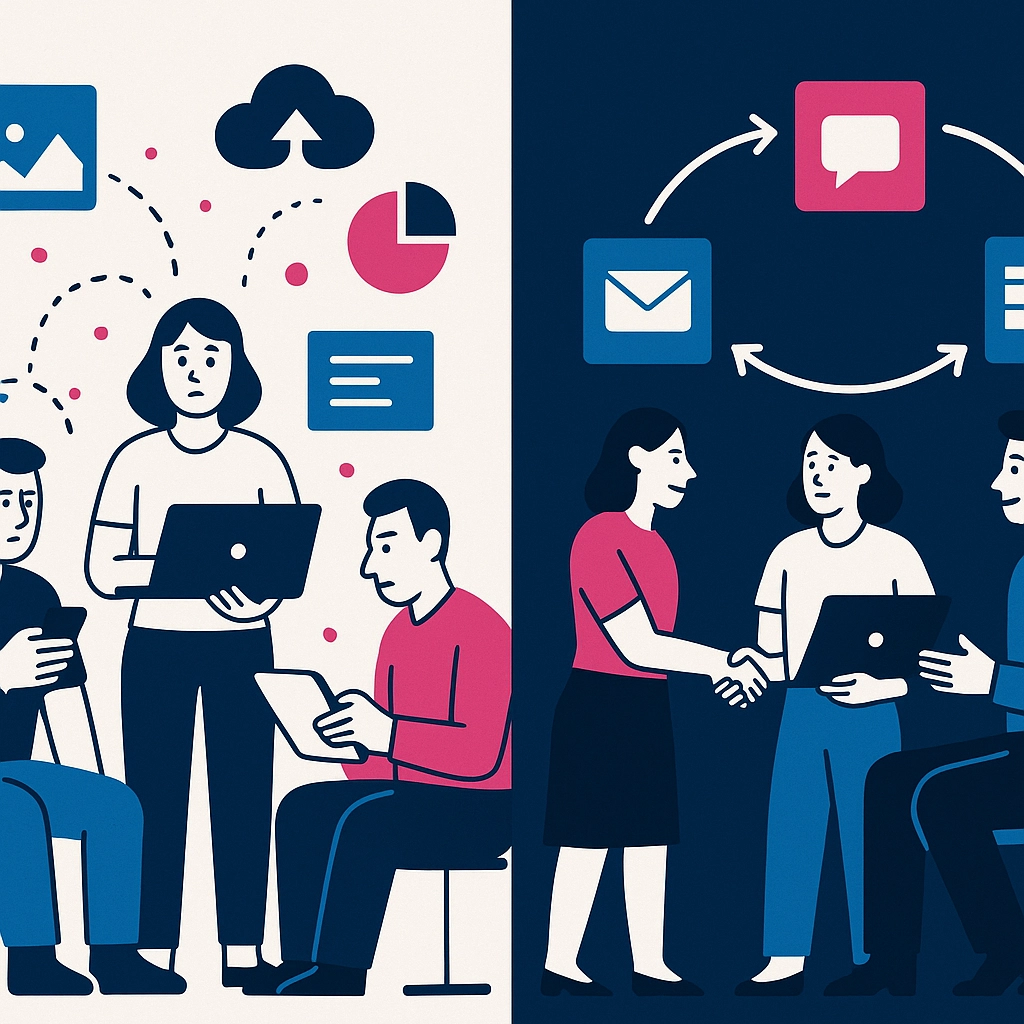Tech Collectors: 80% of companies waste $500K+ on AI tools that never integrate (here's the strategic approach that works)
- gtkilb
- Aug 11
- 5 min read

AI FOMO: Why Tech Curiosity Isn’t Enough
At Enaiblement, we’ll admit it, we love tech. We’re the first in line to test every new language model (Claude, GPT-4o, Gemini, Llama, Deepseek, Perplexity), play with the latest Agentic AI (Manus, flowith NEO, ChatGPT Agent), connect automation stacks (Make.com, Zapier, n8n, Gumroad, Cassidy.AI), and nerd out on AI-powered hardware (Rabbit R1, Meta RayBans). Ask us about the newest AI video or voice tool, and we’ll probably overwhelm you with a demo and detailed notes.
But we don’t buy the hype that just experimenting with the shiniest tools is a business strategy. Because your customers, your teams, and your budget don’t care if you’ve “collected” every app listed on Product Hunt this month. They care that technology helps them do something better, faster, or smarter with less friction and waste.
Here’s the dirty secret the AI industry is just starting to admit: 80% of AI projects never make it past the prototype phase, and most companies burn through at least $500K (if not much more) on tools that barely get used, fail to integrate, and ultimately add up to clutter and confusion instead of results.
The Scale of AI Waste Is Hard to Overstate
Let’s get blunt: Enterprise AI project failure is out of control. Need proof? Check these recent stats:
80% of AI projects stall out before they ever make a dent in your business, usually dying in the prototype or pilot stage (Gartner, 2024).
Only 30% of AI projects go live, and even fewer ever achieve their intended business impact.
In just one year, companies scrapping their AI pilots shot up from 17% to 42%. That’s almost half of all businesses pulling the plug after already writing big checks.
Some of the world’s most public AI flameouts (like Zillow’s $500M loss on its failed home pricing model) show that even big budgets aren’t a safety net.
If you open up the books at most midsize or enterprise firms, you’ll find piles of unused licenses, half-implemented bots, and disconnected platforms paid for but left in the digital junk drawer—costing each organization hundreds of thousands (if not millions) each year.

Why Are So Many Companies Flushing Cash on “Innovation”?
It’s not for a lack of effort or curiosity. Modern business and IT leaders are smart. The problem isn’t that they don’t know how to use tools. The pitfall? Most organizations still mistake “adopting technology” for “solving problems.” Here’s where things go sideways:
1. Data Isn’t Ready, and AI Can’t Fix It
Study after study shows data readiness is the single biggest predictor of AI success or failure. Nearly 42% of AI delays or dead-ends are blamed on data messiness: silos, outdated information, and inconsistent formats. (You know the drill: Sales is on one CRM, Ops on another, and nothing talks to each other.)
Strikingly, even organizations who believe they have great data centralization see over half their projects flop. The reason? Most overlook the need for real-time access, clean governance, and rigid data quality standards, not just a fancy “data lake.”
2. The Platform Trap: Bigger Isn’t Better
Vendors love to promise that a unified AI platform will make everything smoother, faster, and easier for your overworked teams. But researcher after researcher keeps finding the opposite: Unified platforms cause bottlenecks. They force updates on broad, slow release cycles, and teams spend more time wrangling the platform than extracting value.
Example: Compare a one-size-fits-all “news alert” system that everyone ignores to a nimble, best-in-breed tool that pulls quotes directly from 10-Ks, news, your data (with sources!) for your reps; customizable, actionable, and updated in real-time. Speed, flexibility, and actual business value are what best-in-class tools bring. Shout out to our friends over at MileHighAiconsulting who just released MyAugie!
3. “Shiny Object Syndrome” and Redundancy Risk
When every department chases its favorite new app (hello, AI-powered project manager #4), you end up with disconnected systems and overlapping workflows. The consequences:
Redundant spending: Same function, different department, double the bill.
Integration headaches: Disconnected tools require custom glue code (if anyone bothers).
Cybersecurity risk: More platforms = more vulnerabilities.
Training fatigue: Confused employees, lost productivity, and “shadow IT” workarounds.

Strategic Implementation: What the Winners Do Differently
You can’t just keep buying new tools and hoping this time it’ll be different. Companies who consistently get AI to pay off aren’t just “tech enthusiasts”, they’re strategically obsessive. Here’s what sets them apart:
1. Data-First, Always
Before plugging in a single AI tool, especially in workflows like information handoffs between sales, customer experience, or marketing, these companies:
Map all their critical data flows (where it is, who owns it, how clean it is).
Invest in true data centralization (not just lip service).
Build rigorous data governance and real-time access policies.
Address security and compliance up front (not after the fact).
Proof? Organizations that nail data governance and accessibility are 2x more likely to see actual ROI from AI initiatives (Deloitte, 2024).
2. Strategic “Test-and-Integrate” Mindset
Tech leaders at successful firms don’t just test every tool for fun (though we totally get the impulse!). Instead, they:
Treat every pilot as an intentional, limited sandbox, with a clear business hypothesis (not tech for tech’s sake).
Rapidly validate assumptions, killing failures before they cost too much, doubling down on early winners.
Measure “integration readiness”: tools must connect to core platforms like Salesforce or Dynamics and fit naturally into existing processes.
At Enaiblement, we’ve seen the magic happens not just when you demo cool tech, but when you can drop it into a process as a true force multiplier. Whether that’s automating a tedious CRM update, auto-notifying sales after a new lead is scored by an LLM, or routing handoff tasks between teams without missing a beat.

3. Best-of-Breed, Not Monolithic
Forget chasing “one platform to rule them all.” Instead, winning teams:
Select AI-native tools that go deep on their specialty (e.g., HeyGen for video, ElevenLabs for voice, n8n for automation).
Demand extensibility and open APIs so each tool legitimately connects (no one-offs).
Orchestrate platforms around their business needs, not vendor lock-in or “suite” pressure.
4. Change Management Isn’t an Afterthought
Every tool, even the ones you’ve begged for, requires people to change habits. Leading companies invest in simple, focused onboarding, clear documentation, and real support for adoption. They track distribution, not just which tools get licensed, but which ones get used.
AI Spending: How Much Is At Stake?
Why does all this matter? Because AI tool waste isn’t just theoretical. Today:
The average midsize company spends $675K annually on unused SaaS/AI licenses (2024, Zylo SaaS Management Benchmark).
Over $500K per year per company gets burned on tools that never cross the “pilot to production” threshold (Gartner, 2024).
The indirect costs - time wasted managing, connecting, and troubleshooting unused platforms - add up to thousands of lost work hours.
It’s real money and real opportunity slipping away.
What Makes enAIblement Different
Here’s our (not so) secret: We love trying new tech, but we love saving clients from wasted spend even more. We’ve built our consulting around helping customers cut through the noise:
We independently test the latest tools and report the pros and the pitfalls.
We map your current stack, probing for hidden redundancies, security gaps, and data barriers.
We design integration plans that fit your actual workflows. For example, linking new LLM-driven smart workflows to Salesforce or Dynamics so deals don’t disappear into the void.
We only recommend what builds long-term advantage (and, yes, we’ll push back if something’s a bad fit).
The Bottom Line
You’ll probably never convince us to stop tinkering with every fresh launch on the AI horizon. But here’s what a decade of real-world AI adoption teaches: Cool tech is worthless without strategic implementation. Data-first, best-of-breed, and deliberately integrated tools always win out over the latest hype. If you’re tired of seeing expensive platforms gather dust, it’s time for a partner who won’t just collect shiny objects, but turns them into real value.
Ready to stop collecting and start connecting? For a limited time, book a free consult with our team at enaiblement.com.
Want more research like this? Explore our other deep dives:


Comments